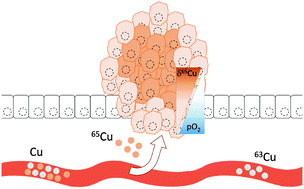Hypoxia induces copper stable isotope fractionation in hepatocellular carcinoma, in a HIF-independent manner†
Abstract
Hepatocellular carcinoma (HCC) is the most frequent type of primary liver cancer, with increasing incidence worldwide. The unrestrained proliferation of tumour cells leads to tumour hypoxia which in turn promotes cancer aggressiveness. While changes in the concentration of copper (Cu) have long been observed upon cancerization, we have recently reported that the isotopic composition of copper is also altered in several types of cancer. In particular, we showed that in hepatocellular carcinoma, tumour tissue contains heavier copper compared to the surrounding parenchyma. However, the reasons behind such isotopic signature remained elusive. Here we show that hypoxia causes heavy copper enrichment in several human cell lines. We also demonstrate that this effect of hypoxia is pH, HIF-1 and -2 independent. Our data identify a previously unrecognized cellular process associated with hypoxia, and suggests that in vivo tumour hypoxia determines copper isotope fractionation in HCC and other solid cancers.



 Please wait while we load your content...
Please wait while we load your content...